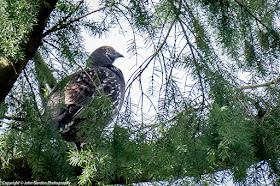April 28 2017 Richmond Nature Park West.
When I arrived at the Richmond East Nature Park there were more birders than hummingbirds. The appearance of a black-chinned Hummingbird*, a very rare visitor to the Lower Mainland was causing quite a stir.
*
*
I'm posting an email chain between Melissa Hafting and Sheri Williamson regarding the identity of the purported Black-chinned Hummingbird at Richmond Nature Park. Please see below.
Good Birding,
Ilya Povalyaev
South Surrey, BC
Hi All,
I got a response from Sheri Williamson. She is an expert on Hummingbirds and the author of "A Peterson Field Guide to Hummingbirds of North America." She has confirmed this bird is a male Anna's Hummingbird crossed with a Black-chinned Hummingbird. Kudos to Don Cecile for picking this up. I have cc'd Wayne Weber so he is aware for eBird.
See her response below. Feel free to post to vanbcbirds
Hi, Melissa,
Don Cecile also sent me some photos of this bird, which is definitely not a pure Black-chinned. The big-headed shape, dull, narrow chinstrap, and too-extensive violet are all indicative of hybrid origin.
Despite the violet gorget color and apparent lack of crown iridescence, two features particularly evident in Peter Candido's back view (which I hadn't seen previously) point strongly toward Anna's as the other parent: the long, deeply notched tail, inconsistent with Rufous, Calliope, Broad-tailed, or Costa's parentage; and shortish secondary coverts, an Anna's trait expressed intermediately in its hybrids. If perched side views can be obtained, I would expect them to show slight graduation of primary widths and faint notches on the inner vanes of P1-5, suggestive of Black-chinned, combined with a slight asymmetry to the outermost secondary coverts, an intermediate expression of another Anna's trait.
Hope this helps.
Good birding,
Sheri L. Williamson
Bisbee, Arizona
 |
| Anna's and Rufous Hummingbirds emptied a feeder in front of our eyes. |
Someone remarked that there had been one several years ago but it had not been photographed.
 |
| Anna's Hummingbird. |
I took these Anna's (above) and Rufous (below) while waiting for the Black-chinned.
 |
| Rufous Hummingbird (Male) |
 |
| Rufous Hummingbird (Female) |
I spent an hour photographing the Black-chinned Hummingbird. I eventually had thirty frames to choose from. Twenty frames were identical with the bird feeding. The trick was to get a shot as it backed off from the feeder. Unfortunately every time it did, the other hummers chased it off.
 |
| Hummingbird Black-chinned/Anna X. |
 |
| The Black-chinned Hummingbird (above) came to the feeder fewer than three times in an hour compared to the Anna's and Rufous which fed continuously. |
"It's never too late to start birding"
John Gordon
Langley/Cloverdale
BC Canada








































